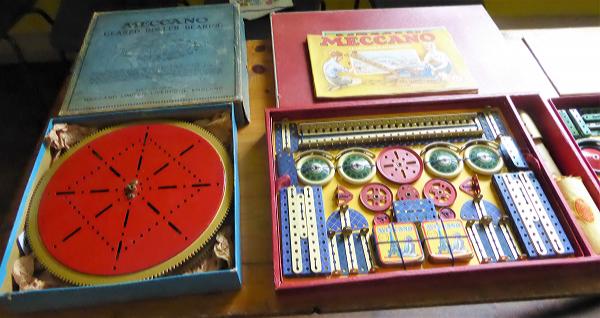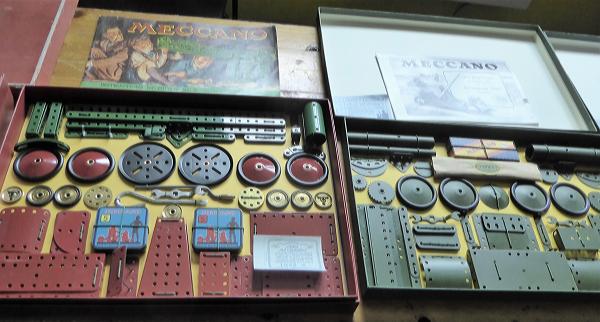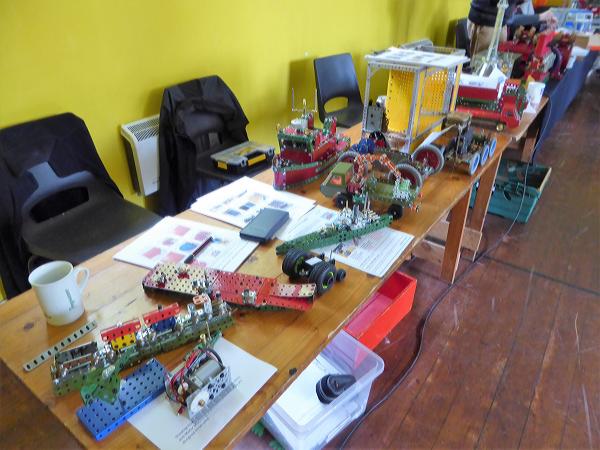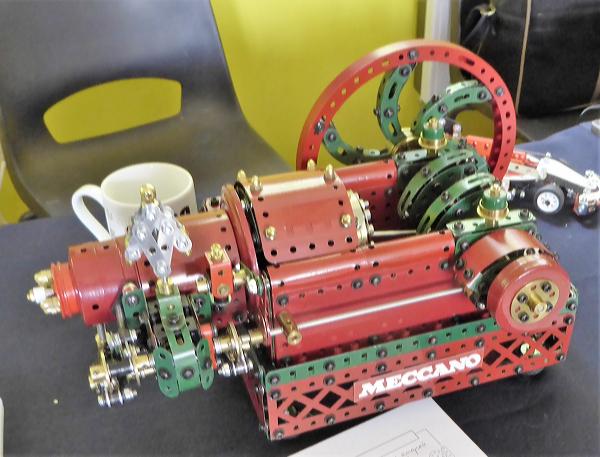The Meccano Society of Scotland
Menstrie Meeting 2022
In May 2022 we held our annual Menstrie Meeting. The challenge this year was to build a machine from standard and/or compatible Meccano parts that is able to stop itself upon reaching an objective point on the Menstrie Scout Hall floor.
Menstrie Challenge - Report (by Andrew Knox)
The Menstrie Challenge suggested by David Stanford in late 2019 finally took place in May 2022. At various of the MSoS meetings during 2021/22 it was agreed that the Society should proceed with the original challenge, albeit delayed somewhat. Members produced some very creative solutions to what is actually quite a tricky problem.
In summary, the aim was to build an autonomous self-propelled model able to travel to a fixed point on the Scout Hall floor and stop when reaching the objective point. Three heats were held: 5’, 12’ and 18’ distance, and the score was the aggregate radial distance between the datum on the vehicle and the fixed point. The model with the lowest score after the three heats would be the overall winner. In the event of a draw after three heats a further, longer distance would be used as the tie-breaker, but in the event this was not required.
There were a total of nine entries to this year’s competition with the scoring as follows:
| Entrant | Heat 1 (5’) | Heat 2 (12’) | Heat 3 (18’) | Total |
|---|---|---|---|---|
| Chris Shute (3rd) | 2” | 2½” | 10¼” | 14¾” |
| Alastair Innes (2nd) | 1¾” | ⅝” | 3” | 5⅜” |
| Douglas Carson | 2” | 7¼” | 7¾” | 17” |
| Alan Blair | 8” | 19½” | 9” | 36½” |
| Andy Knox (1st) | ½” | 1⅛ | 2” | 3⅝” |
| Gordon & Shelia Stewart | 1⅞” | 3½” | 41” | 46⅛” |
| Gordon Stewart | 6¼” | 23” | 23½” | 52¾” |
| Shelia Stewart | 6¼” | 6⅝” | 17½” | 30⅜ |
| Brendan Harris | Withdrawn |
There are three main factors to consider when designing the model:
1. Keeping it moving in a straight line;
2. Stopping at the correct distance;
3. Alignment with the target point on the floor.
A secondary consideration is the time limit for the journey from the start line to the datum point.
The first three machines all used a similar gear arrangement to travel a specific distance, albeit implemented in different ways.
Chris’ model used a clockwork motor and a large circular strip with a set of datum points corresponding to the distance to be travelled. Before release, the machine was set to that distance. It terms of absolute distance accuracy this was most impressive.
The score achieved was predominantly due to deviation from a straight line. Alastair’s machine (second left) used a falling weight geared to the rear wheels, with the wheels being used to wind up the weight to a corresponding distance before launch.
This was a most elegant contraption, almost silent when running, and constantly accelerated until the driving wheels locked up using the brake mechanism.
Coming to a stop was a rather oscillatory affair, with a second & third forwards-backwards motion imparted by the rebound of the weight at the end stop. One can only marvel at Alastair’s dedication to calibrating the machine!
Andy’s entry used an electric motor and a battery to drive a pair of gear trains connected by a differential. Before the run started the gear train was wound to the required distance and during the run the motor unwound the gears via the differential. This was not as accurate as Chris’ model but did tend to go in a straighter line. All in all the competition was a great success and it was refreshing to see so many of the Members and guests present at various stages during the day.
Pictures from Menstrie 2022
High resolution versions of the photos are also available for download if desired.

Photo - David Stanford
Menstrie 14/05/22 - Overview. (14/05/2022)
Click here to see higher resolution photo

Photo - David Stanford
Menstrie 14/05/22 - Overview. (14/05/2022)
Click here to see higher resolution photo

Photo - David Stanford
Menstrie 14/05/22 - Overview. (14/05/2022)
Click here to see higher resolution photo

Photo - David Stanford
Menstrie 14/05/22 - Metallus Auction Lots. (14/05/2022)
Click here to see higher resolution photo

Photo - David Stanford
Menstrie 14/05/22 - Meccano Auction Lots. (14/05/2022)
Click here to see higher resolution photo

Photo - David Stanford
Menstrie 14/05/22 - Meccano Auction Lots. (14/05/2022)
Click here to see higher resolution photo

Photo - David Stanford
Menstrie 14/05/22 - Challenge Winner - Andy Knox. (14/05/2022)
Click here to see higher resolution photo

Photo - David Stanford
Menstrie 14/05/22 - Challenge 2nd Place - Alastair Innes. (14/05/2022)
Click here to see higher resolution photo

Photo - David Stanford
Menstrie 14/05/22 - Challenge 3rd Place - Chris Shute. (14/05/2022)
Click here to see higher resolution photo

Photo - David Stanford
Menstrie 14/05/22 - Challenge - Douglas Carson. (14/05/2022)
Click here to see higher resolution photo

Photo - David Stanford
Menstrie 14/05/22 - Challenge - Alan Blair. (14/05/2022)
Click here to see higher resolution photo

Photo - David Stanford
Menstrie 14/05/22 - Challenge - Brendan Harris. (14/05/2022)
Click here to see higher resolution photo

Photo - David Stanford
Menstrie 14/05/22 - Challenge - Gordon And Sheila Stewart's Joint Entry (14/05/2022)
Click here to see higher resolution photo

Photo - David Stanford
Menstrie 14/05/22 - Challenge - Gordon And Sheila Stewart's Individual Entries. (14/05/2022)
Click here to see higher resolution photo

Photo - David Stanford
Menstrie 14/05/22 - Angus Plumb's Vectis Auctions purchases including the geared roller bearing that appeared in the Vectis TV program "Scouting for Toys". (14/05/2022)
Click here to see higher resolution photo

Photo - David Stanford
Menstrie 14/05/22 - Angus Plumb's Vectis Auctions purchases. (14/05/2022)
Click here to see higher resolution photo

Photo - David Stanford
Menstrie 14/05/22 - Angus Plumb's Vectis Auctions purchases. (14/05/2022)
Click here to see higher resolution photo

Photo - David Stanford
Menstrie 14/05/22 - Dave Stanford's models in the foreground. (14/05/2022)
Click here to see higher resolution photo

Photo - David Stanford
Menstrie 14/05/22 - Douglas Carson's models in the foreground. Chris Schenk's lorries in the background. (14/05/2022)
Click here to see higher resolution photo

Photo - David Stanford
Menstrie 14/05/22 - Chris Schenk's ferry and Andy Knox's models. (14/05/2022)
Click here to see higher resolution photo

Photo - David Stanford
Menstrie 14/05/22 - Andy Knox's gas engine. (14/05/2022)
Click here to see higher resolution photo

Photo - David Stanford
Menstrie 14/05/22 - George Roy's gas engine. (14/05/2022)
Click here to see higher resolution photo

Photo - David Stanford
Menstrie 14/05/22 - George Roy's tractor. (14/05/2022)
Click here to see higher resolution photo

Photo - David Stanford
Menstrie 14/05/22 - Brendan Harris's models. Citroen Van ready for CAM. (14/05/2022)
Click here to see higher resolution photo

Photo - David Stanford
Menstrie 14/05/22 - Ken McDonald's models. (14/05/2022)
Click here to see higher resolution photo

Photo - David Stanford
Menstrie 14/05/22 - Ken McDonald's dumper truck. (14/05/2022)
Click here to see higher resolution photo

Photo - David Stanford
Menstrie 14/05/22 - Ken McDonald's cement mixer. (14/05/2022)
Click here to see higher resolution photo

Photo - David Stanford
Menstrie 14/05/22 - Colin Blackhall's lorry. Alan Blair's small tug in the background. (14/05/2022)
Click here to see higher resolution photo

Photo - David Stanford
Menstrie 14/05/22 - Bert Hutchings's models. (14/05/2022)
Click here to see higher resolution photo
Tip - You may find it better to view the pictures in 'full screen' mode - For most browsers F11 will toggle this on and off.
© 2024 Meccano Society of Scotland

